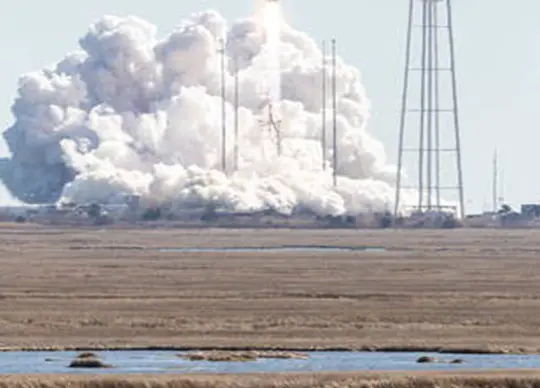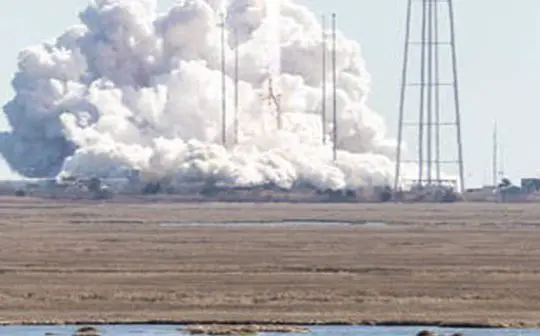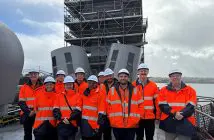
A fresh supply of 8,300 pounds of scientific investigations and cargo launched from NASA’s Wallops Flight Facility in Virginia at 12:40 p.m. EST on Saturday, Feb. 19, aboard a Northrop Grumman Cygnus resupply spacecraft, and is now traveling to the International Space Station.
The Cygnus spacecraft, which was launched on an Antares rocket, is scheduled to arrive at the space station around 4:35 a.m. on Monday, Feb. 21. NASA Television, the NASA app, and agency’s website will provide live coverage of the spacecraft’s approach and arrival beginning at 3 a.m.
NASA astronauts Raja Chari and Kayla Barron will capture Cygnus with the station’s robotic Canadarm2 upon its arrival. The spacecraft will then be installed on the Earth-facing port of the station’s Unity module.
This is Northrop Grumman’s 17th contracted resupply mission under the second Commercial Resupply Services contract with NASA. The delivery includes critical materials to support dozens of the more than 250 science and research investigations occurring during NASA’s Expedition 66 mission aboard the space station.
The scientific investigations Cygnus is carrying include:
Protecting Our Skin
Deterioration of skin tissue, a normal part of aging, occurs over decades. Microgravity leads to changes in the body like aging but that occur much more quickly, so they can be more easily studied. Colgate Skin Aging will evaluate cellular and molecular changes in engineered human skin cells in microgravity. Results may help speed development of products aimed at protecting skin from the aging process on Earth.
Testing Tumor Drugs
MicroQuin 3D Tumor will examine the effects of a therapeutic on breast and prostate cancer cells. These cells can grow in a more natural 3D model in microgravity, which makes it easier to characterize their structure, gene expression, cell signaling, and response to the treatment. Results could provide new insight into the cell protein targeted by the drug and help advance development of other cancer drugs.
Improving Hydrogen Sensors
The Advanced Hydrogen Sensor Technology Demonstration will test new sensors for the space station’s oxygen generation system. Current sensors ensure that none of the hydrogen enters the cabin oxygen but can be sensitive to moisture, nitrogen, and other issues that require them to be swapped out every 201 days. This technology could provide more durable sensors for situations where rapid replacement is not practical, reducing the number of spares needed on longer space missions such as to the Moon or Mars.
Better Batteries
Space Demonstration for All Solid-State Li Ion Battery (Space As-Lib), an investigation from the Japan Aerospace Exploration Agency, will feature the operation of a lithium-ion secondary battery capable of safe, stable operation under extreme temperatures and in a vacuum environment. The battery uses solid, inorganic, and flame-retardant materials that do not leak, making it safer and more reliable. Results could demonstrate the battery’s performance for various potential uses in space and other planetary environments. Solid-state batteries also have potential applications in harsh environments and the automotive and aerospace industries.
Plants in Space
Current systems for growing plants in space use soil or a growth medium. These systems are small and do not scale well in a space environment due to mass, containment, maintenance, and sanitation issues. To address these issues, eXposed Root On-Orbit Test System (XROOTS) will use water- and air-based methods instead, reducing overall system mass. Results could provide insight into the development of larger-scale systems to grow food crops for future space exploration and habitats. Components of the system could also enhance plant cultivation in greenhouses on Earth and contribute to better food security.
Improving Fire Safety
Solid Fuel Ignition and Extinction (SoFIE) will enable studies of the flammability of materials and ignition of fires in realistic atmospheric conditions. This facility uses the Combustion Integrated Rack (CIR), which allows for testing at different oxygen concentrations and pressures that represent current and planned space exploration missions. Gravity influences flames on Earth, but in microgravity, fire acts differently and can behave in unexpected ways aboard the space station.
Some evidence suggests that fires may be more hazardous in reduced gravity. Results could help ensure crew safety by improving design of extravehicular activity suits, and cabin materials, improve our ability to determine the best techniques for suppressing fires in space.
Findings from these and other investigations aboard the space station will contribute to keeping astronauts healthy during long-duration space travel and demonstrate technologies for future human and robotic exploration missions as part of NASA’s Moon and Mars efforts, including lunar missions through the agency’s Artemis program.
Cygnus will also deliver critical hardware to be installed during the upcoming ISS Roll-Out Solar Array (IROSA) spacewalks, as well as other components for the successful functioning of astronaut life on the space station, such as a trash deployer and acoustic covers for the waste management system.
This Cygnus mission is the first to feature enhanced capabilities that will allow the spacecraft to perform a reboost, using its engines to adjust the space station’s orbit as a standard service for NASA. The agency has one reboost is planned while Cygnus is connected to the orbiting laboratory. A test of the maneuver was performed in 2018 during Cygnus’ ninth resupply mission.
Cygnus will remain at the space station until May before it deploys CubeSats, then disposes of several thousand pounds of trash during its re-entry into Earth’s atmosphere, which will result in its destruction.
Image: Northrop Grumman’s Antares rocket liftoff from pad 0A at 12:40 p.m. EST from NASA’s Wallops Flight Facility in Virginia, on Feb. 19, 2022. The Cygnus spacecraft, carrying 8,300 pounds of science investigations and cargo, is scheduled to arrive at the space station on Monday, Feb. 21. Credits: NASA Wallops/Allison Stancil





